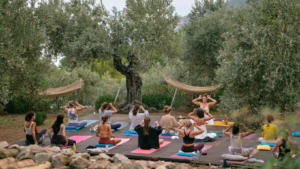Introduction
Welcome to our definitive guide on planning educational retreats! Whether you’re orchestrating a leadership retreat, a strategic planning session for your board, or a lively family retreat, our aim is to equip you with essential insights and tools for a triumphant event. This guide navigates the complexities of retreat planning, from setting clear goals to selecting the ideal retreat location.
In this journey, we’ll delve into various retreat types, including strategic planning retreats, faculty-focused leadership development sessions, and engaging group retreats for higher education or professional development. Each retreat demands meticulous planning, a keen understanding of the participants, and a well-crafted activity roster to ensure success.
Introducing Hobnob, our innovative Digital Invitation app, revolutionizing retreat organization. Hobnob streamlines communication, simplifying guest interaction, RSVP collection, photo management, and instant updates. It’s an indispensable tool for coordinating your upcoming retreat, ensuring efficient group organization and planning.
Our guide will also cover the essentials of creating a successful retreat, from fostering team building and leadership skills to ensuring a memorable and transformative experience for all attendees. Whether it’s choosing the right retreat facility or setting an engaging agenda, we’ll provide you with the strategies needed for a successful and impactful retreat.

Understanding the Purpose of Your Retreat
The cornerstone of planning educational retreats lies in pinpointing the specific purpose of your event. This initial step is crucial, as it shapes the strategic plan and overall direction of your retreat, whether it’s a leadership retreat, a professional development session, or a board retreat. Identifying this purpose guides every aspect of the retreat planning process, from the selection of the retreat center to the activities and sessions planned.
Your retreat might focus on various themes, such as leadership development for faculty in higher education, team building for a corporate group, or even a family or church retreat aimed at strengthening bonds. Each type demands a tailored approach in planning, facilitation, and execution. In strategic planning retreats, for example, the goal might be to formulate a long-term action plan or to foster team cohesiveness and clarity in a leadership team.
The selection of the retreat facility, the duration of the retreat (a longer retreat versus a shorter session), and the choice of facilitator (an internal leader or an outside facilitator) are critical elements that can greatly influence the retreat’s effectiveness. These decisions should align with the retreat’s objectives, ensuring that each agenda item and activity directly contributes to achieving these goals.
Strategic Planning: A Core Element
Strategic planning stands as a pivotal element in the orchestration of educational retreats, particularly when they involve leadership teams or focus on higher education. This process is fundamental in shaping the retreat, whether it’s a leadership, board, or strategic planning retreat aimed at professional development. The success of a retreat is often underpinned by a well-crafted strategic plan, which guides every aspect of the event.
Key to this planning process is setting a clear and cohesive agenda that aligns with the retreat’s overall objectives. This involves careful selection of both the retreat facility and the facilitator, whether it’s an internal leader or an outside facilitator, to ensure they complement the retreat’s goals. For instance, choosing a serene environment for a yoga retreat or a structured setting for a board retreat can significantly impact the outcome.
Strategic planning involves defining clear expectations for participants and attendees, ensuring every activity, from team building to brainstorming sessions, is purposeful and contributes to the overarching goal. This approach is especially crucial in longer retreats, where there is more opportunity to explore complex topics in-depth and integrate various ideas into a comprehensive action plan.

Selecting the Right Retreat Center
Selecting the appropriate retreat facility is a critical decision in the planning of educational retreats, as it sets the tone and atmosphere for the entire event. The choice of location is pivotal, whether you’re envisioning a tranquil setting for a yoga retreat, a dynamic space for a church retreat, or a professional environment for a corporate or leadership retreat. The retreat center must not only resonate with the retreat’s theme but also support the planned activities and agenda.
For those organizing a retreat focused on leadership development, higher education, or professional development, finding a retreat facility that fosters an environment conducive to learning and engagement is essential. This could mean selecting a location that offers both quiet spaces for reflection and strategic planning, as well as areas suitable for team-building activities and group discussions.
When planning longer retreats, it’s particularly important to ensure that the retreat center can comfortably accommodate all participants. This includes considering the sleeping arrangements, dining facilities, and meeting spaces. The facility should be able to cater to the needs of your team, faculty, or family, ensuring a comfortable and productive stay for all attendees.
The retreat location plays a significant role in setting the right mood and ambiance for the retreat. For instance, a yoga retreat might require a peaceful and serene setting, while a church retreat might look for a location that inspires spirituality and community bonding. Similarly, a retreat focused on strategic planning or board meetings might need a more formal setting equipped with the necessary technology and amenities.
Organizing and Facilitating Your Retreat
Effective facilitation is essential for the success of any retreat, whether it’s focused on strategic planning, leadership development, or team building. The choice of facilitator is crucial, whether it’s an adept outside facilitator or a capable member of your leadership team. This individual should be skilled not only in managing the planning process but also in engaging participants effectively, ensuring active involvement and collaboration throughout the retreat.
The facilitator’s role is particularly vital in educational retreats, including those in higher education or professional development contexts. They should be proficient in steering discussions and activities towards the retreat’s strategic goals, especially in board retreats or sessions centered around strategic planning.
Incorporating small group activities and team-building exercises is a strategic approach to enhance collaboration and idea-sharing among attendees. These activities, tailored to the group’s dynamics, are instrumental in achieving the retreat’s objectives, contributing to a more cohesive and productive experience.
Overall, the facilitation of a retreat demands a balance of strategic organization and engaging activity management. This ensures that every aspect of the retreat, from the planning to the execution, aligns with the intended goals, making it a valuable and impactful experience for all participants.

Incorporating Digital Tools: Hobnob

In the dynamic world of retreat planning, digital tools like Hobnob have become invaluable, especially for organizing educational and professional development retreats. Hobnob, our advanced digital invitation app, emerges as a strategic partner in planning and managing events like leadership retreats, board retreats, and even family or church retreats.
This app streamlines communication with guests, simplifying the process of sending out invites and collecting RSVPs for your upcoming retreat. Whether it’s for a team-building session, a faculty retreat, or a strategic planning retreat, Hobnob makes these tasks effortless and efficient.
Beyond invitations, Hobnob offers real-time chat functionality, enabling continuous engagement with your guests. This feature is particularly beneficial for fostering a sense of community ahead of the retreat, crucial for team building and leadership development events.
Additionally, Hobnob is a versatile tool for photo management and sharing, enhancing the interactive experience for attendees. Its capability to send instant text updates is vital for keeping everyone informed, especially in retreats with multiple activities or locations.
The app also aids in organizing groups for future events, making it a practical tool for regular retreat planning, such as in corporate or higher education settings.
Team Building and Professional Development Activities
Team building activities are a great opportunity for leadership development and fostering a sense of unity among faculty and participants. Team building and professional development activities are essential in educational retreats, particularly for leadership and strategic planning retreats. These activities are not just for enjoyment; they play a crucial role in leadership development and in fostering unity among faculty, participants, and the leadership team.
Aligning these activities with your retreat’s strategic plan and goals is vital, whether it’s a retreat at a retreat center, a board retreat, or even a family retreat. This ensures that each team building activity, from brainstorming sessions to physical exercises, contributes meaningfully to the retreat’s objectives, especially in higher education and professional development contexts.
The choice of facilitator, whether an internal leader or an outside facilitator, is key in guiding these activities. They should be skilled in engaging participants and keeping the activities aligned with the retreat’s agenda and goals.
In longer retreats, these activities can be more in-depth, allowing for a deeper exploration of professional development topics and more complex team-building exercises. This approach should be integrated into the retreat’s planning process with clear expectations and a defined action plan to ensure the effectiveness of the team-building sessions and their alignment with the overall goals of the retreat.
Setting Clear Expectations and Creating an Action Plan
In the realm of organizing successful retreats, whether it’s for educational purposes, leadership development, or strategic planning, setting clear expectations for attendees is a fundamental step. This clarity is essential not just in the context of a corporate or leadership retreat, but also in higher education retreats, professional development sessions, and even family or church retreats. By establishing these expectations, every participant, from faculty members to student services personnel, can have a precise understanding of the retreat’s purpose, the agenda, and their specific role or contribution to the event.
Clear expectations are also instrumental in facilitating the planning process, ensuring that all activities, whether they are team-building exercises or brainstorming sessions, are aligned with the retreat’s objectives. This approach enhances the effectiveness of the retreat, whether it’s held at a retreat center, involves a small group, or caters to a larger assembly of attendees.
The development of a clear action plan post-retreat is equally vital. This action plan should encapsulate the ideas, strategies, and goals discussed during the retreat and provide a roadmap for implementing them. A well-defined action plan helps in translating the insights gained during the retreat into tangible outcomes, whether it’s for strategic planning in a corporate context, leadership team development, or specific initiatives in higher education.
For retreats that involve complex themes, such as a strategic planning retreat or a board retreat, having a structured action plan is even more crucial. It ensures that the momentum and insights gained during the retreat are not lost but are instead channeled into constructive and strategic actions.
Incorporating facilitation methods that encourage active participation and idea-sharing can greatly enhance the quality of the action plan. An effective facilitator, whether an internal leader or an outside facilitator, can guide this process, helping to synthesize the diverse ideas and insights from the participants into a cohesive and actionable plan.
Planning for Upcoming Events and Student Services
In the realm of higher education and student services, retreats are a strategic opportunity to focus on both upcoming events and the specific needs of students. These retreats serve as an ideal platform for strategic planning, allowing faculty, leadership teams, and student services personnel to collaboratively brainstorm and align their efforts with institutional objectives.
Such retreats provide a conducive environment for gathering valuable feedback from participants. This input is crucial for improving student services and planning future activities, including major campus events and new student engagement strategies. The retreat setting, away from daily campus activities, fosters creativity and open discussion, essential for effective strategic planning.
Additionally, these retreats can strengthen team dynamics among staff, enhancing the delivery of student services. Choosing the right retreat facility is important to support these goals, providing a space that encourages both focused planning sessions and informal idea exchanges.
Conclusion
The journey of organizing an educational retreat, encompassing everything from family retreats to church retreats, leadership retreats, and professional development sessions, is a multifaceted endeavor that demands meticulous strategic planning and execution. At the heart of this process is the development of a strategic plan, tailored to the unique needs and goals of your retreat, whether it’s for a board retreat, a session in higher education, or a team-building exercise for your leadership team.
A successful retreat is characterized by a harmonious blend of meaningful activities and well-defined objectives. Engaging in team-building activities is more than just a way to break the ice; it’s an integral part of leadership development, fostering collaboration and unity among faculty, participants, or any small group involved. Utilizing digital tools like Hobnob elevates this experience, simplifying the planning process, from sending invites to managing the retreat agenda, and ensuring clear communication with all attendees.
Selecting the right retreat facility also plays a crucial role. Whether it’s a serene location for a yoga retreat or a well-equipped center for a strategic planning retreat, the venue should align with your retreat’s theme and facilitate the planned activities. The role of a skilled facilitator, be it an internal leader or an outside facilitator, cannot be overstated in guiding the retreat and ensuring that each agenda item is addressed and every participant feels engaged.
For those involved in planning retreats in higher education or student services, these events present a great opportunity to focus on upcoming events, strategic initiatives, and student needs. Setting clear expectations and creating a detailed action plan post-retreat are essential steps in translating the insights and strategies discussed into actionable outcomes.






















